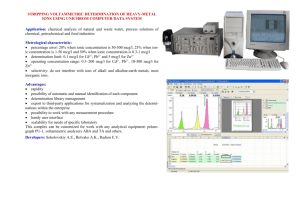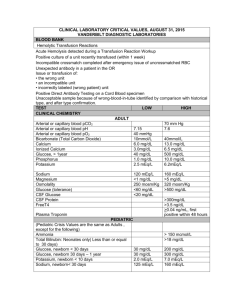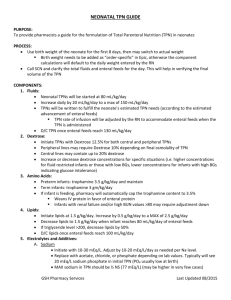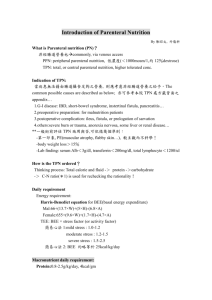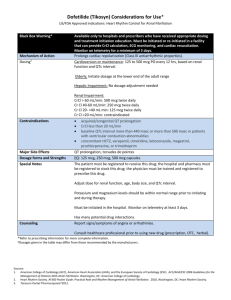Guidelines for Creating TPN Orders
advertisement
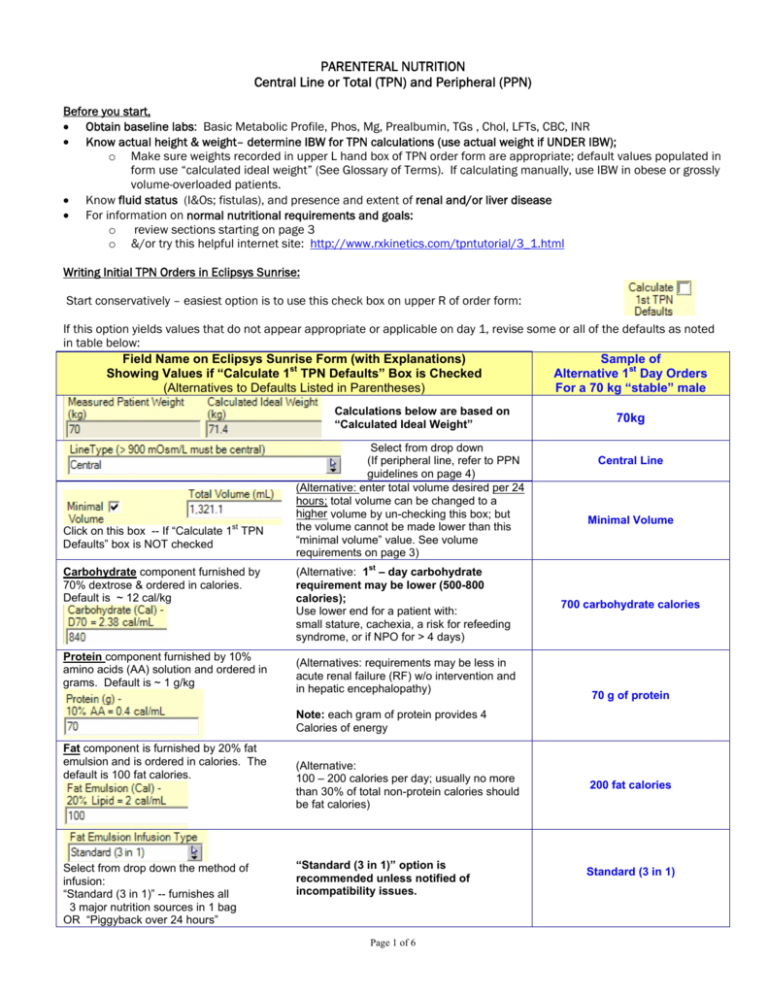
PARENTERAL NUTRITION Central Line or Total (TPN) and Peripheral (PPN) Before you start, • Obtain baseline labs: Basic Metabolic Profile, Phos, Mg, Prealbumin, TGs , Chol, LFTs, CBC, INR • Know actual height & weight– determine IBW for TPN calculations (use actual weight if UNDER IBW); o Make sure weights recorded in upper L hand box of TPN order form are appropriate; default values populated in form use “calculated ideal weight” (See Glossary of Terms). If calculating manually, use IBW in obese or grossly volume-overloaded patients. • Know fluid status (I&Os; fistulas), and presence and extent of renal and/or liver disease • For information on normal nutritional requirements and goals: o review sections starting on page 3 o &/or try this helpful internet site: http://www.rxkinetics.com/tpntutorial/3_1.html Writing Initial TPN Orders in Eclipsys Sunrise: Start conservatively – easiest option is to use this check box on upper R of order form: If this option yields values that do not appear appropriate or applicable on day 1, revise some or all of the defaults as noted in table below: Field Name on Eclipsys Sunrise Form (with Explanations) Sample of Showing Values if “Calculate 1st TPN Defaults” Box is Checked Alternative 1st Day Orders (Alternatives to Defaults Listed in Parentheses) For a 70 kg “stable” male Calculations below are based on “Calculated Ideal Weight” st Click on this box -- If “Calculate 1 TPN Defaults” box is NOT checked Carbohydrate component furnished by 70% dextrose & ordered in calories. Default is ~ 12 cal/kg Protein component furnished by 10% amino acids (AA) solution and ordered in grams. Default is ~ 1 g/kg Select from drop down (If peripheral line, refer to PPN guidelines on page 4) (Alternative: enter total volume desired per 24 hours; total volume can be changed to a higher volume by un-checking this box; but the volume cannot be made lower than this “minimal volume” value. See volume requirements on page 3) st (Alternative: 1 – day carbohydrate requirement may be lower (500-800 calories); Use lower end for a patient with: small stature, cachexia, a risk for refeeding syndrome, or if NPO for > 4 days) (Alternatives: requirements may be less in acute renal failure (RF) w/o intervention and in hepatic encephalopathy) 70kg Central Line Minimal Volume 700 carbohydrate calories 70 g of protein Note: each gram of protein provides 4 Calories of energy Fat component is furnished by 20% fat emulsion and is ordered in calories. The default is 100 fat calories. Select from drop down the method of infusion: “Standard (3 in 1)” -- furnishes all 3 major nutrition sources in 1 bag OR “Piggyback over 24 hours” (Alternative: 100 – 200 calories per day; usually no more than 30% of total non-protein calories should be fat calories) “Standard (3 in 1)” option is recommended unless notified of incompatibility issues. Page 1 of 6 200 fat calories Standard (3 in 1) Field Name on Eclipsys Sunrise Form (with Explanations) Showing Values if “Calculate 1st TPN Defaults” Box is Checked (Alternatives to Defaults Listed in Parentheses) Sample of Alternative 1st Day Orders For a 70 kg “stable” male Shows latest lab information; Review closely & make daily adjustments of any or all nutrients. This cation may be furnished as chloride, phosphate or acetate anions (see Glossary) Default is 1 mEq/kg This cation may also be furnished as chloride, phosphate or acetate anions Default is to use acetate for the balance of + + the Na and K cations ordered and not furnished by the amounts of chloride or phosphate ordered below; Use drop down to switch to chloride (Alternative range between 1 – 2 mEq/kg) nd (2 alternative is to calculate total volume and order amount equivalent to ½ NS or 77 mEq per Liter ordered) 100 mEq Na 70 mEq K (Alternative: 1 mEq per gram of protein) This grayed-out field gives calculated amount of the anion being used (acetate or chloride): Balance with acetate + + This anion furnished as Na or K ; Usually defaults to the number of sodium cations ordered Default is 0.15 mM/kg 100 mEq Cl This element furnished as Na+ or K+ phosphate; (Alternatives: 7 mM/1000 cal; less for renal failure; more as metabolic demand increases) 10 mM Furnished as calcium gluconate (Alternative range: 10 – 20 mEq) 15 mEq Furnished as magnesium sulfate (Alternative range: 12 – 20 mEq) 16 mEq Other additives Displayed on Form For micronutrient amounts in MVI & Trace Elements, see last page of guidelines 600 mcg furnished by MVI 200 mg furnished by MVI Default is none; may be ordered weekly or monthly from drop-down. MVI has 150 mcg Vit K (this is the minimum recommended amount). Fat emulsion has additional ~25 mcg Vit K per 100 mL of fat. Defaults to none; 2.5 mg provided by trace elements; add 5 mg if patient has catabolic stress; add 10 – 15 mg if patient has large GI losses Defaults to none; 10 mcg provided by trace elements; add 10 mcg if patient has large GI losses or is glucose intolerant Page 2 of 6 Avoid adding insulin to TPN if possible; use basal insulin detemir every 12 hours. Use of a regular insulin SS is no longer recommended. Continue to monitor glucoses every 6 hours and adjust basal insulin PRN. Do not add if patient already on a PPI (pantoprazole of esomeprazole) Determining the Volume of TPN orders Macronutrients (Carbohydrates, Protein, and Fat) make up the majority of the volume; exact volumes for all additives may be viewed on the bottom of the order form. Here is the first line of default volumes for the default entries on page 1. To manually calculate the volumes: CHO: Standard solution is dextrose 70% (D70W). This means 70 g per 100 mL or 0.7 g/1 mL There are 3.4 cals per g of CHO; Thus 1 mL = 0.7 gm = 2.38 cal e.g: 700 CHO cals / 2.38 ~ 294mL Protein: Standard solution is 10% amino acids (AA). This means 10 g per 100 ml or 1 g per 10 mL e.g: 70g protein x 10 = 700mL Fat: Standard solution is a 20% fat emulsion which contains additional additives to yield 2 cals per mL e.g: 200 fat calories = 100mL Additives: Volumes vary (exact volumes are given at bottom of form); usually Estimated Total Volume from sample day 1 TPN = ~ 200mL 294 mL D70W 700 mL amino acids 100mL fat emulsion 200mL additives ~1294mL / day (this is the minimal volume) If additional free water needed, “uncheck” the “Minimal” volume box and write total volume as needed – difference will be made up with sterile water; e.g. if 2000mL total needed, ~700mL sterile water will be added to above sample day 1 TPN. Determining Goals DAILY PROTEIN & CALORIE REQUIREMENTS Adapted from JPEN 2004 and http://www.rxkinetics.com/tpntutorial/3_1.html Note from link above: While protein provides 4 calories of energy per gram, it is needed for tissue synthesis & repair and is not routinely used to calculate basic energy requirements. The inclusion of protein in the calculation of energy requirements (called total calories vs. non-protein calories), is controversial. In a hypermetabolic (stressed) patient, protein may be used for energy – usually between 10 – 20 % of total. PROTEIN Maintenance Catabolic patients Chronic renal failure (renal replacement therapy) Acute renal failure + catabolic ENERGY Total calories : Non-protein-calories: 70 – 85% as carbohydrate (CHO) 15 – 30 % as fat FLUIDS 0.8 – 1 g/kg 1.2 – 2 g/kg 1.2 -- 1.5 g/kg 1.5 – 1.8 g/kg 20 – 30 kcal/kg (usual max CHO utilization rate is 20 – 25 kcal/kg/day; ) 30 – 40 mL/kg Page 3 of 6 Assess YOUR patient’s requirements: Sample patient: 70 kg Male; volume overloaded; Estimated TOTAL caloric requirement: 30 cal/kg = 2100 cal/day Estimated protein requirement: 1.5 g/kg = 105 g Protein/day = 420 cal Usual initial CHO cal utilization rate ~4 mg/kg/min, or ~20 cal/kg/day = 1400 CHO cal Need to use fats to make up difference to reach caloric goals: 2100 TOTAL cal – (1400 CHO cal + 420 Protein cal) = 280 fat cals per day (can round to 300 fat cal) TPN goals for this sample patient: (NOT on the 1st day) 1400 CHO cals 105g protein 300 fat cals Volume = + + + Total “minimal” volume = 588mL 1050mL 150 mL 200 mL from other additives ~1988 mL/day For most patients, you can start on Day 1 with about half of the protein and non-protein-calorie goals. Increase daily, as tolerated, to goals, usually in 3 to 4 days. Adjust electrolytes and additives as indicated by current status, daily labs, fluid balance, etc. If patient is malnourished, titration to max protein and caloric goals may take longer due to the risk for “refeeding syndrome” (see Glossary of Terms). In these patients, start with 1/3 of protein and caloric goals, and progress slowly. Too rapid a correction of protein & caloric depletion increases the risk. To reduce the risk, correct electrolyte abnormalities before starting nutritional support and use daily electrolytes (K+, Phos, Mg) to guide advancement; e.g. if low, do not increase macronutrients until electrolytes stable without requiring bolus replacements. Monitoring (enter standing orders): Daily x first week: Basic Metabolic Profile, Mg, Phos, CBC (When stable, decrease to once or twice a week.) Daily: Weight, Accuchecks as indicated, Accurate I&Os, Vitals Weekly: TGs, LFTs, PREalbumin, CRP-standard (unless otherwise indicated) Once PN infusing, (Pertains to both TPN and PPN): 1. Orders must be submitted before 3pm DAILY 2. Bags infuse over 24 hrs, eg: from ~ 4pm to 4pm 3. Bags are discarded at the 24-hr mark, to decrease risk of contamination. PPN (Peripheral Parenteral Nutrition) Requires significant volume, to maintain “safe” osmotic load to peripheral vein (< 900mOsm/L ) ∴ NOT indicated for patients requiring fluid restriction. Rules of Thumb: Days 1 & 2 Total Vol (mL) 2200 CHO cals 500 Fat cals 500 g Protein 70 mEq Na, Cl (avg ~1/2NS) 165 • • • • • • Day 3, if stable 2600 650 650 75 200 If est’d Nutrition needs not yet met, and large volume tolerated: Day 4 Day 5 3100 3300 800 1000 800 1000 85 100 250 290 Electrolytes follow same basic principles as central TPN, except for Na and Cl as indicated Monitor for infiltration; do NOT use TPN orders in peripheral vein; though PPN can be infused via a central line Change line or switch to central line for TPN within 7-10 days, depending on venous integrity Monitor labs, weights, etc., as with TPN Line should be changed every 3 or 4 days or more often if irritation develops Addition of heparin is no longer recommended; the addition of fats and keeping the osmolarity below 900 mOsm/L should minimize peripheral vein irritation Page 4 of 6 GLOSSARY OF TERMS Acetate Anion An anion that is a precursor or “supplier” of bicarbonate (Sodium bicarbonate is incompatible in TPN solutions); used when acidosis is present or a risk A negatively-charged ion; Anions pertinent when ordering electrolytes for TPN solutions are chloride, phosphate, and acetate; The number of anions and cations ordered in a TPN must “balance” because they can only be supplied as a combination of the following salts: sodium chloride &/or potassium chloride; sodium phosphate &/or potassium phosphate; sodium acetate &/or potassium acetate Basic Metabolic Profile New term for the old “Chem 7” lab order which includes: Serum Sodium, Potassium, Chloride & Calcium; Total Serum Carbon Dioxide; Anion Gap; Serum Glucose; Blood Urea Nitrogen; Serum Creatinine Cal The common abbreviation for kilocalories (the standard unit of energy used in clinical nutrition); Carbohydrates and protein provide 4 calories per gram; Fat provides 9 calories per gram (our fat emulsion has additives that boost that number to 10 cal/gm) Calculated Ideal Weight Based on a body-mass index formula that is useful for all heights including the very short or very tall. The usual methods of calculating the Ideal Body Weight (Devine or Robinson) cannot be used if height is less than 5 feet. Cation A positively-charged ion; Cations pertinent when ordering electrolytes for TPN solutions are sodium and potassium; The number of cations and anions ordered in a TPN must “balance” (see “anion” above) CBC The “Complete Blood Count” lab order which includes: White Blood Cell Count & Red Blood Cell Count; Hemoglobin & Hematocrit MCV, MCH, MCHC, RDW; Nucleated RBC & Absolute Nucleated RBC Platelet Count and an Automated Interpretation. Chem 7 Old term for the Basic Metabolic Profile (see above) CHO Carbohydrate Chol Serum Cholesterol CRP There are two lab tests for CRP or C-reactive Protein : • The standard test assesses the “general degree of inflammation” (choose this one) • The “high Sensitivity” test assesses “CARDIAC risk” IBW Ideal Body Weight; see “Calculated Ideal Weight” above INR International Normalized Ratio; the ratio of a patient’s prothrombin time to a normal (control). JPEN The Journal of Parenteral and Enteral Nutrition LFTs Liver Profile lab order which includes: Serum Albumin, Total Serum Protein; Direct &Total Bilirubin; Serum AST/SGOT, and ALT/SGPT; and Serum Alkaline Phosphatase Mg Serum Magnesium Phos Serum Phosphorus PPI Proton Pump Inhibitor; if patient is on one, there is no need to add an H2-blocker like famotidine. Refeeding Syndrome TG A syndrome caused by initiating feeding too rapidly in severely malnourished patients. The sudden increase in metabolic demand causes a decrease in circulating levels of potassium, magnesium and phosphorus. The sequelae may affect every organ system and may lead to cardiac arrhythmias, heart failure, acute respiratory complications, paralysis, nephropathy, and liver dysfunction. (Definition adapted from http://www.rxkinetics.com/tpntutorial/3_3.html). This reference also helps identify patients at risk) Serum Triglyceride Page 5 of 6 Information on Micro-nutrients Micro-nutrient Recommended Daily Adult Requirements JPEN 2004 Furnished by Pharmacy Preparation Listed MVI Adult (Hospira) As of Dec 2008 Amounts per 10 mL Thiamine (B1) Riboflavin (B2) Niacin (B3) 6 mg 3.6 mg 40 mg 6 mg 3.6 mg 40 mg Folic acid Pantothenic acid Pyridoxine (B6) Cyanocobalamin (B12) Biotin 0.6 mg 15 mg 6 mg 5 mcg 60 mcg 0.6 mg 15 mg 6 mg 5 mcg 60 mcg Ascorbic acid (C) Vitamin A Vitamin D Vitamin E 200 mg 3300 IU 200 IU 10 IU 200 mg 3300 IU 200 IU 10 IU 150 mcg 150 mcg Vitamin K Total “1st-Day Default” Amounts Various individual Supplements Default Additional Amounts Thiamine Inj 100 mg/mL 100 mg Folic Acid Inj 5 mg/mL No additional Ascorbic acid 500 mg/mL No additional Fat emulsion 20% ~25 mcg / 100 mL 106 mg 3.6 mg 40 mg 0.6 mg 15 mg 6 mg 5 mcg 60 mcg 200 mg 3300 IU 200 IU 10 IU ~ 175 mcg Phytonadione Inj 10 mg/mL No additional Trace Elements (American Regent) as of Dec 2008 Default Amounts per 2.5 mL Various individual Supplements Total “Default” Amounts Chromium 4 mcg/mL Chromium Copper Manganese 10- 15 mcg 0.3 – 0.5 mg Less in Hepatobiliary Disease 60 – 100 mcg Less in Hepatobiliary Disease 10 mcg / 2.5 mL 2.5 – 5 mg 2.5 mg / 2.5 mL No additional 10 mcg 1 mg / 2.5 mL 1 mg 250 mcg / 2.5 mL 250 mcg Zinc Sulfate 1 mg/mL Zinc No additional 2.5 mg Selenium Inj 40 mcg/mL Selenium 20 – 60 mcg Note: long-term TPN use requires serum monitoring of trace elements including aluminum to avoid toxicity 40 mcg ©2008 Genevieve (Jenny) Gallus, RD, LD, CNSD Rosa C. Garcia, RPh Revised January 2009 Page 6 of 6 40 mcg
